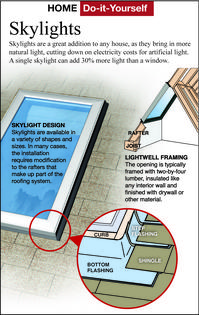Here's How: Build a Lightwell Under a Skylight
Dear James: I want to add a skylight to my family room to make it seem larger and more open, but there is an attic above it. Is it still possible to add a skylight? -- Jason G.
Dear Jason: You'll be pleasantly surprised by the impact adding a skylight can have on the perceived openness and size of a smaller space. The increased brightness and qualities of natural sunlight will draw your family members into that room.
Although it is a little trickier to install a skylight in a room with an attic above it as compared to a vaulted or cathedral ceiling, more than half of all skylights are installed this way. The actual installation of the skylight in the roof is identical, but you will have to build a lightwell from your ceiling to the skylight in the roof.
Before you start cutting holes in the roof, first determine the type of skylight (flat or domed, glass or plastic, fixed or venting) that you want. A fixed, domed, plastic one is probably the easiest to install and definitely the least expensive option.
The size of the skylight is also critical for effective lighting and for aesthetic balance. If it is too small, it will look silly. If it is too big, it will create glare and result in too much energy loss. A rule of thumb is to multiply the square footage of the room by .045 to determine the proper square foot size of the skylight.
Go up on the roof and determine where you want the skylight to be located. Drill a hole through the roof at about the center of the skylight. Go into the attic. Use the hole as a reference only, because the skylight location should be adjusted to match up with the rafters for proper support. Drill four corner holes up through the roof to show the exact location.
There are two lightwell designs you can use. A straight-walled lightwell is the easiest to build but not the most attractive or effective. With this lightwell design, the opening in your ceiling is the same size as the skylight and the sides are straight.
If you are somewhat handy with tools, a tapered lightwell is a much better design. The open area in your ceiling will be about twice that of the skylight area. It provides better distribution of the sunlight throughout your room and a better view of the sky.
No matter which design you choose, it is extremely important to seal all the joints well with caulking. Silicone caulking is good to use because the temperature inside an attic can get quite high. Go into the attic and glue or nail several inches of rigid foam insulation on the sides of the lightwell. Don't leave any voids.
Once the lightwell is completed, the worst is over. Installing a skylight in the roof is straightforward procedure that is similar for most skylights. The key to a leak-free installation is generous use of caulking and careful fitting of the flashing and shingles.
========
Send your questions to Here's How, 6906 Royalgreen Dr., Cincinnati, Ohio, 45244 or visit www.dulley.com. To find out more about James Dulley and read features by other Creators Syndicate writers and cartoonists, visit the Creators Syndicate website at www.creators.com.
Copyright 2025 Creators Syndicate Inc.






























Comments